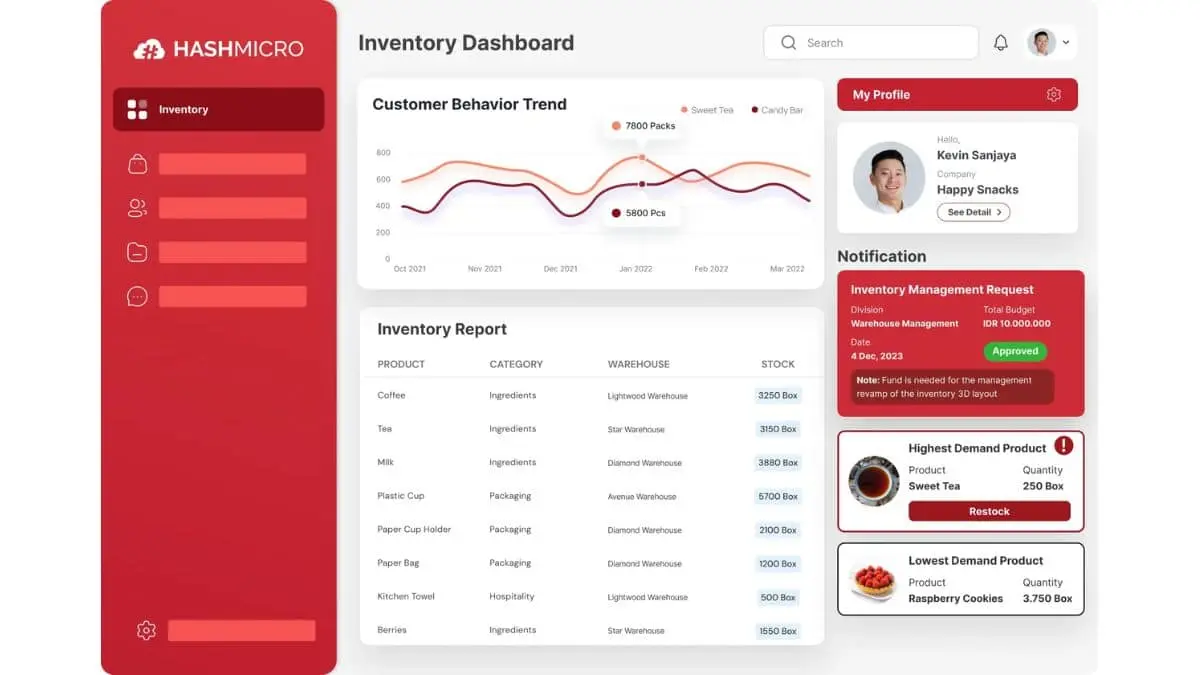Managing inventory efficiently is crucial for the success of businesses in the Philippines. Proper control and tracking of inventory can boost turnover rates, minimize stock-related challenges, and ensure timely fulfillment of orders.
Inventory level refers to the specific amount or quantity of goods and products available in a warehouse or storage location at any given time. This measurement reflects the inventory a company holds to meet customer demand and ensure the smooth flow of production.
For businesses in the Philippines, adopting inventory management strategies that align with the fast-paced market environment is essential. This affects operational efficiency, customer satisfaction, and profitability. By understanding the importance of inventory levels within the supply chain, companies can prioritize high-demand products, avoid stockouts and overstocking, and improve overall stock management.
In this article, we will discuss inventory levels and how to optimize them. Panatilihin ang pagbabasa upang makakuha ng higit pang impormasyon!
Table of Contents

Key Takeaways
|
What is Inventory Level?
Inventory level is the amount or quantity of goods available in a company’s warehouse or storage location at any given time. Inventory level includes various types of goods, such as raw materials, semi-finished goods, and finished products ready for sale.
Effective inventory level management can help companies maintain a balance between demand and supply.When companies have optimal inventory levels, they can ensure that goods are always available when they are needed, thus avoiding stockouts that can result in lost sales and customer confidence.
On the other hand, inventory levels that are too high can lead to large storage costs, risk of item damage, and inefficient spending. To optimally monitor and manage inventory levels, many companies use inventory management systems that enable real-time stock tracking, project inventory needs based on demand, and automate the reorder process.
The Importance of Managing Inventory Levels in the Philippines’ Dynamic Market
In the fast-paced market environment of the Philippines, effectively managing inventory levels is essential for businesses to succeed. How you manage your inventory influences multiple aspects of operations, including efficiency, customer satisfaction, and profitability.
Understanding the importance of level of inventory within the supply chain enables you to make informed decisions that optimize stock management. By focusing on high-demand products and closely monitoring inventory, you can minimize stockouts and overstocking, leading to more efficient inventory management overall.
One of the key drivers for optimizing inventory levels in the Philippines’ dynamic market is the integration of digital tools and technologies. Inventory management software, for example, transforms the way businesses manage inventory, offering real-time tracking, demand forecasting, and data-driven insights to support better decision-making and maintain optimal inventory levels.
Read More: Top Construction Inventory Management Software
Key Benefits of Optimizing Inventory Levels Strategically
Narito ang mga benepisyo ng pagpapatupad ng strategic inventory level management para sa mga negosyo sa Pilipinas:
1. Increased customer satisfaction
By maintaining optimal inventory levels, businesses can meet customer demands quickly, ensuring product availability and timely delivery. This builds trust and increases customer loyalty, leading to repeat business.
2. Reduced storage costs
Managing stock strategically helps companies reduce the amount of goods stored in excess in warehouses. With more controlled stock, storage costs can be reduced, such as costs for storage space, insurance, and product damage. It also helps improve cash flow as funds are not tied up in unnecessary inventory.
3. Stockout avoidance
Good inventory management helps prevent stockout situations, which can lead to lost sales opportunities and lower business reputation. By monitoring demand levels and updating inventory appropriately, companies can ensure they have enough stock to meet customer needs without shortages.
4. Improved operational efficiency
By consistently monitoring inventory and optimizing the flow of goods, companies can manage resources more efficiently. Better operational processes will lead to higher productivity, allow teams to focus on other important tasks, and help companies stay competitive with a more organized workflow.
Inventory levels also can be optimized by implementing another software, like manufacturing inventory software.
The Impact of Digitization on Enhancing Inventory Management
Digitization plays a crucial role in optimizing inventory levels for Filipino companies. With the rise of digital tools and technologies, including ERP systems and cloud-based inventory management software, businesses are witnessing a transformation in level of inventory optimization.
Filipino companies have successfully adopted digital inventory solutions, utilizing them to streamline their inventory processes. These advanced solutions provide real-time monitoring, inventory analysis, and data-driven decision-making, enabling businesses to calculate and maintain optimal inventory levels.
By integrating digitization into inventory management, Filipino companies can enhance their ability to forecast demand, estimate lead times, and determine the economic order quantity. Leveraging tools like an inventory list BIR submission system ensures compliance with regulatory requirements while improving inventory tracking and reporting. This data-driven strategy allows businesses to make informed decisions, ensuring that inventory levels remain optimized at all times.
The benefits of inventory management system for digitization for optimizing inventory levels are extensive. Real-time monitoring helps businesses detect stockouts and replenish inventory quickly, reducing the chances of lost sales and unhappy customers. Additionally, accurate inventory control prevents overstocking, minimizing carrying costs and saving valuable storage space.
In summary, digitization provides Filipino companies with the opportunity to streamline their inventory management processes and achieve optimal inventory levels. By harnessing digital tools and solutions, businesses can improve performance, enhance operational efficiency, and ultimately boost profitability.
Calculating and Maintaining Optimal Inventory Levels
Effective inventory management is essential for the seamless operation of your business. Determining and maintaining optimal inventory levels helps prevent stockouts, lower carrying costs, and ensure timely order fulfillment. Various inventory level formula and practical examples are available to calculate the right inventory levels.
A widely used formula is the economic order quantity (EOQ) formula, which calculates the ideal amount of inventory to order by considering factors such as demand forecasting and lead times. The EOQ formula is as follows:
Where:
- EOQ = Economic Order Quantity
- D = Annual demand
- S = Cost per order
- H = Holding cost per unit
Another valuable formula is the reorder point (ROP) formula, which indicates when to place a new order to prevent stockouts. It takes lead time and average daily demand into account. The ROP formula is as follows:
Where:
- ROP = Reorder Point
- LT = Lead time
- DD = Average daily demand
These formulas offer a foundation for calculating optimal inventory levels, but it’s crucial to adjust them according to your specific business needs and industry. Incorporating practical examples and real-time data ensures more accurate calculations.
For instance, a retail business with seasonal demand fluctuations can analyze historical sales data and apply advanced demand forecasting methods. This enables the business to adjust inventory levels based on upcoming seasons or promotions, ensuring efficient stock replenishment and reducing the risk of overstocking or stockouts.
By consistently monitoring and adjusting your inventory levels, you can maintain optimal stock, reduce carrying costs, and meet customer demand efficiently. Implementing inventory management software can simplify this process by providing real-time insights and automating inventory calculations. Accurate inventory calculations lead to better operational efficiency and increased profitability.
Top Strategies for Ensuring Optimal Inventory Levels
To maintain optimal inventory levels, businesses in the Philippines can follow several best practices, supported by an inventory report, to ensure they have the right amount of stock at all times, preventing stockouts and reducing costs. By adopting these strategies, companies can streamline inventory management and improve overall operational efficiency.
1. Regular inventory audits
One crucial practice for maintaining optimal stock levels is conducting regular inventory audits. These audits help verify that the recorded stock matches the physical inventory, ensuring accuracy. Regular checks also help detect any discrepancies or issues, allowing for immediate corrective action.
2. Automated inventory replenishment
To prevent stockouts and ensure optimal level of inventory, businesses can implement automated inventory replenishment systems. These systems use predefined criteria such as reorder points or sales forecasts to initiate the restocking process automatically. This saves time and ensures that the necessary stock is always available.
3. Just-in-Time (JIT) inventory system
Another effective method is the just-in-time (JIT) inventory system, where businesses only restock inventory when it’s needed. This approach reduces carrying costs and avoids excess stock. By closely monitoring demand and having efficient supply chain processes, businesses can ensure they have the right amount of inventory on hand when required.
By implementing these best practices—regular audits, automated replenishment, and the JIT system—businesses in the Philippines can maintain optimal inventory levels, minimize costs, and prevent stock shortages while ensuring operational efficiency and customer satisfaction.
Key Challenges and Effective Solutions for Inventory Management
Businesses in the Philippines face several challenges in effectively managing inventory levels, with two common issues being demand variability and supply chain disruptions. The following below is a more detailed explanation:
- Demand variability: this challenge can make it difficult to forecast demand and maintain optimal inventory levels accurately.
- Supply chain disruptions: these challenges can cause delays or interruptions in the flow of goods, resulting in potential stock-outs or excess inventory.
So, how to overcome these challenges? One approach is to use data analytics to improve demand forecasting and optimize inventory levels. By analyzing historical sales data and market trends, businesses can make informed decisions about stock replenishment, ensuring that inventory matches actual demand.
Another solution is to implement inventory management software. This software automates inventory tracking, monitors stock movements, and offers real-time insights into inventory levels. With accurate data, businesses can make smarter decisions about when to reorder stock or adjust safety stock levels.
One of the best examples of an inventory system in the Philippines that you can use is the HashMicro inventory system. This system is specifically designed to manage inventory needs, one of which is inventory level management.
In addition, the HashMicro system can help your business to establish reliable reorder points and safety stock levels based on demand variability and lead times. By using this system, your business can strike a balance between avoiding stock-outs and minimizing excess inventory. Interested?
If you are interested in this system, HashMicro is happy to invite you to try a free demo that can be accessed anytime and anywhere by clicking here!
Improve Inventory Level Management Efficiency with HashMicro System
HashMicro Inventory Management Software is an efficient and accurate inventory level management solution for businesses of all sizes. This web-based cloud inventory system solution is complete for businesses of all sizes, including wholesale, retail, food and beverage, construction, manufacturing, real estate, and more.
HashMicro also provides a free demo for companies who want to learn more about the inventory software Philippines. The good news is that the free demo they offer does not require any commitment such as a subscription and can be accessed at any time.
Furthermore, another advantage of this software is that it can be integrated with other applications to further simplify the management of your business. So, you not only get a system that can manage inventory, but also an all in one system for all business needs. Napaka pakinabang, tama?
Here are the features offered by the HashMicro system:
- RFID Warehouse rack stock in out automation: Automates the tracking of stock in and out movements on warehouse racks, improving inventory management efficiency and accuracy.
- Packaging management: Assists in the organization and efficient storage of goods and easy tracking of inventory.
- Racking Capacity with Putaway Strategy: Assist warehouse team in getting detailed information related to the placement of goods to small locations in the warehouse without having to remember them.
- Stock Optimizer per Warehouse: Maximizes overall warehouse space usage and improves operational efficiency in stock management.
Conclusions
Optimizing inventory levels is critical to the success of business operations, as it ensures the availability of the right goods at the right time, reducing the risk of stock shortages and excess inventory. With optimal inventory management, companies can improve efficiency, reduce storage costs, and ensure customer satisfaction through fast and precise demand fulfillment.
Implementing technology, such as HashMicro’s inventory management system can help companies monitor and manage stock in real-time, so that decisions are more accurate and strategic in the face of market dynamics.
Schedule a free demo now!

























